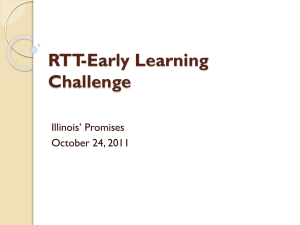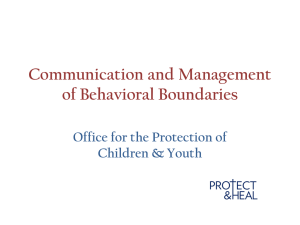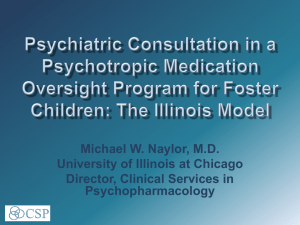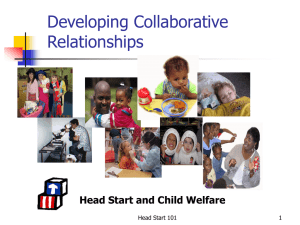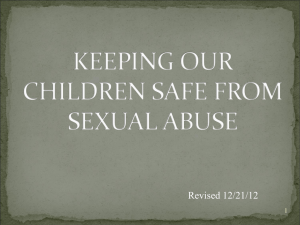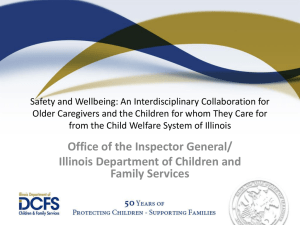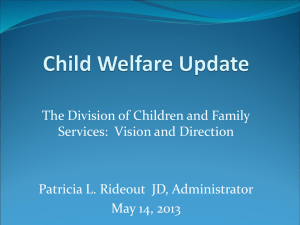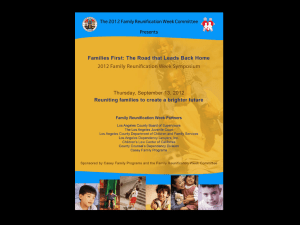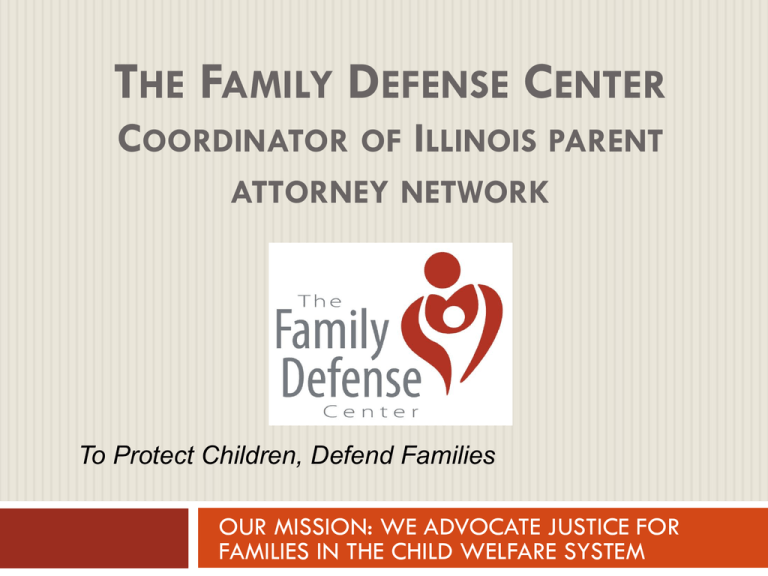
THE FAMILY DEFENSE CENTER
COORDINATOR OF ILLINOIS PARENT
ATTORNEY NETWORK
To Protect Children, Defend Families
OUR MISSION: WE ADVOCATE JUSTICE FOR
FAMILIES IN THE CHILD WELFARE SYSTEM
FDC’s Overall Goals
Long
term program goals—Help families; change
policies and practices; prevent unwarranted removals
of children and blacklisting of professionals;
Limit
child protection intervention to children truly
endangered by their parents or caregivers and enable
good caring parents and professionals to carry on their
lives with minimal intrusion by the child welfare system.
Conform
the system to due process requirements
Mothers’
Defense Project: goal of changing genderbiased policies and practices that impair mothers’
ability to raise their children
Goals for Today’s Training
Provide background and context to the DCFS child
protection/investigations system and the
expungement appeal process
Enable you to provide adequate to excellent
representation for a parent or child care
professional in a DCFS expungement hearing
Provide legal background (constitutional, statutory
and rule/policy) regarding DCFS decisionmaking in
protective custody and other investigative actions
PART I: DCFS Investigations
OUR FOCUS:
CHILD PROTECTION INVESTIGATIONS
CHILD PROTECTION INVESTIGATIONS are the
“front end” of the child welfare system
During investigations, CRITICAL DECISIONS are
made:
(A)
Is the child safe? (a “no” decision leads to safety
plans and possible juvenile court)
(B) Is the accused person “guilty” (“indicated”)?
It is horrible to be falsely-accused of the
worst thing in the world: child abuse
The stigma of an accusation doesn’t go away,
even with exoneration
Parents who go through the child protection
system bear irreparable scars—and so do
their children
Parents who have been falsely-accused lose
faith in the legal system if they cannot access a
fair hearing
The lawyer’s role:
The best remedy for a wrongful accusation and
the threats of family dissolution or wrongful
blacklisting is effective legal counsel
Families often want to hold the State’s child
protection system accountable
Effective advocacy during an investigation can
minimize the impact of a subsequent juvenile
court case, or avoid a court case altogether
CHILD PROTECTION INVESTIGATIONS:
THE PICTURE NATIONALLY
An epidemic of child abuse reporting!
6,000,000 ALLEGED VICTIMS in 2009
BUT, few than 700,000 of those cases were
substantiated or indicated under a variety of standards
At least 75% of all cases allege neglect, not abuse
The public image of the “epidemic” of child abuse is AT
ODDS with the REAL STATISTICS:
THE UNTOLD STORY
For every 100 children reported to be the victim of
maltreatment, only 1-2 are actually the victim of
serious physical or sexual abuse.
Many children and families are the victims of false
reporting and those scars can last permanently too!
According to case records compiled in Dupuy v. Samuels:
Of the people who appealed the investigators’
“indicated” findings of abuse or neglect, 74.5% were
cleared of wrongdoing after a neutral hearing—an
expungement rate the federal court called
“staggering.”
THE ILLINOIS CHILD WELFARE SYSTEM—
HOW IT STARTS
Illinois DCFS receives over 250,000 Hotline
calls per year (258,000 in 2011); 101,000
children were subjects of these calls.
In 2011, 28,000 children were found to be
subjects of an “ indicated ” report of
abuse/neglect.
HOW MANY CHILDREN ARE REALLY
VICTIMS OF ABUSE/NEGLECT, and HOW
MANY ARE ACTUALLY VICTIMS OF FALSE
REPORTING/FALSE FINDINGS?
THE HOTLINE: OVERUSED, UNDERUSED OR BOTH?
In 1974, child abuse reporting became a national
requirement under CAPTA/Mondale Act (note the
political spin on the reference to the Act).
Since 1974, every state has adopted child abuse
reporting procedures but the specifics of what is subject
to reporting and how determinations of abuse are
made differ dramatically from state to state
Illinois is at the forefront of procedural reform to insure
a fairer system of determination, thanks to
Dupuy v. Samuels (FDC case).
WHAT IS THE “HOTLINE”
A DATABASE
A CHILD ABUSE REGISTER
(WHERE INDICATED
REPORTS ARE MARKED)
AN OFFICE IN
SPRINGFIELD
A PHONE NUMBER (1800-25-ABUSE)
AN EMPLOYMENT
BLACKLIST
(CANTS/LICENSING
CHECKS)
THE START OF
INVESTIGATIONS AND
SERVICE CASES
THE PRIMARY
SCREENING/TRIAGE
SYSTEM
DESPITE MAJOR IMPROVEMENTS
OVER-REPORTING
Mandated reporters are taught to report questionable cases
Just about every professional except for attorneys are “mandated
reporters”
“When in doubt” reporting is one cause of system overload
Anonymous and biased reports are allowed
Penalties for false reporting don’t work: Cook County reports no
prosecutions and getting a prosecution is just about impossible.
RESULT: The system still encourages “indicated findings” even in
cases where the Hotline caller knows the case to be weak.
SCREENING OF HOTLINE CALLS
DCFS RUNS THE HOTLINE FROM SPRINGFIELD
MINIMAL SCREENING:
Is
there a child?
Is there something alleged?
Does what is alleged fit within one of DCFS’
“Allegations of Harm?”
IF SO, CASE IS SENT TO “THE FIELD”
WHO IS “THE FIELD”?
MANDATE WORKER—
Must see the child (or
make a good faith
attempt to do so) within
24 hours of the Hotline
call
ASSIGNED CPI/DCP
INVESTIGATOR
SUPERVISOR
AREA ADMINISTRATOR
(New position—
combination of Child
Protection Manager and
Assistant Regional
Administrator positions)
NOTE: MAY HAVE
PARALLEL WORKERS
WHO IS “THE FIELD”
DCFS investigators are required to have a B.A. and
two years of some social service experience
Not trained as judges
Given sweeping powers to tear families apart or
leave them alone, and to adjudicate guilt or
innocence
Training is not adequate for the job—about 50
hours to get started (and Illinois is better than many
states!)
THE LEGAL FRAMEWORK
DCFS OPERATES UNDER ENUMERATED STATUTORY POWERS:
1. The Abused and Neglected Child Reporting Act (ANCRA,
325 ILCS 5/1 et seq.)
This is the primary Act governing investigations and “indicated”
findings
2. The Children and Family Services Act (20 ILCS 505/1 et seq.)
This is the Act that creates DCFS and sets forth the Department’s
service delivery and foster care responsibilities.
3. The Juvenile Court Act (705 ILCS 405/1 et seq.)
This Act determines custody/parental rights in abuse/neglect cases
that actually go to court.
A Tour of DCFS’ Rules and Procedures
Primary Rules and Procedures (promulgated pursuant to
ANCRA):
Rule and Procedure 300
Investigations, generally
Rule and Procedure 300, Appendix B
Specific “Allegations of Harm”
Rule 336
Appeals process
How they are organized:
Rules are codified in the Illinois Administrative Code.
Each Rule has a corresponding Procedure—same
numbering!
http://www.state.il.us/dcfs/policy/index.shtml
Three Types of ALLEGATIONS
DCFS Categorizes each accusation into one of their
pre-defined “Allegations of Harm”
Each Allegation fits into one of the following
general categories:
1. Abuse ONLY
2. Neglect ONLY
3. Abuse OR Neglect
For a full list of the different “Allegations of Harm,”
see Appendix D of the Training Manual.
Abuse ONLY
Examples:
“Tying/Close
Confinement”
“Sexual Molestation”
“Sexual Exploitation”
“Substantial Risk of Sexual Injury”
“Abuse only” allegations are all coded by a
single number under 30.
E.g., “Tying/Close Confinement” is Allegation #14
Neglect ONLY
Examples:
“Inadequate
Supervision”
“Medical Neglect”
“Inadequate Food”
“Inadequate Shelter”
“Neglect only” allegations are all coded by a
single number over 30.
E.g., “Inadequate Supervision” is Allegation #74
Either Abuse OR Neglect
Examples:
“Bone
Fractures”
“Human Bites”
“Cuts, Bruises, Welts, Abrasions and Oral Injuries”
“Substantial Risk of Physical Injury / Environment
Injurious to Health and Welfare”
These allegations will be coded with two
numbers: one under 30 AND one over 30
E.g., “Bone Fractures” is Allegation #9/59
• If the appellant is accused of causing the bone fracture by
ABUSE (i.e., “direct action”), it is Allegation #9
• If the appellant is accused of causing the bone fracture by
NEGLECT (i.e., “blatant disregard”), it is Allegation #59
A person cannot be accused of
both abuse and neglect
Occasionally, DCFS will allege that an appellant
committed both abuse and neglect in the same
incident
Logically, both are not possible.
Often, there is a real incident that occurred, but is
it abuse? Is it neglect? Or is it an excusable
accident? A child’s medical condition? Or the fault
of someone else?
Special Circumstance:
Allegation #60, “Environment Injurious”
Julie Q. v.
DCFS
IL Appellate Court
(2d Dist) held that
“Environment
Injurious” is VOID
AS A MATTER OF
LAW
Now pending with
the Illinois
Supreme Court!
“Environment Injurious” is the “neglect” allegation
that corresponds with “substantial risk”
Language had been affirmatively removed from
ANCRA in 1980
In 2000, DCFS promulgated a Rule purporting
to authorize Departmental action based on an
“environment injurious”—has since become
DCFS’s most ubiquitous allegation.
In 2011, Appellate Court ruled the allegation to
be LEGALLY VOID
New Legislative Language
Pub Act 97-803 (eff. 7-13-12)
2012 legislative session: S.B. 2489 seeks to reinsert
“environment injurious” within ANCRA’s definition of
“neglected child”
Coalition of agencies was successful in ensuring that the
final bill included language creating legal thresholds for
identifying an “environment injurious”
Must be a likelihood of harm
Must be due to blatant disregard of caretaking responsibilities
DCFS still operating under the old definition as it
appeared in the administrative rule prior to Julie Q. and
new legislation
INITIAL NOTICES
Given at the beginning of investigation
KEY NOTICE IS CANTS 8
Amended after Dupuy
litigation—now
includes a lengthy
notice of rights
RIGHTS IN INVESTIGATION
Explains who is a
Child Care Worker
Explains right to
present evidence
Explains the right to
appeal an indicated
finding
Provides the nature of
the allegation
Ends the misleading
idea that it is
“confidential”
DUPUY RIGHTS
Right to PRE-DEPRIVATION process:
Administrator’s Conference
The right to Dupuy processes must be made during the investigation,
or the pre-deprivation process will NOT be provided
FDC has been pressing for “automatic” qualification in which Dupuy
status is obvious
Clarification points for Dupuy qualification:
15-hour threshold
For school teachers, tenure is preclusive (union membership is NOT)
Personal capacity cases
Career entrant
DCFS CLAIMS TO LIBERALLY ALLOW QUALIFICATION
Required Investigative Contacts
28
Each “Allegation of Harm” has its own definition within
DCFS’ Rules and Procedures 300, Appendix B
The definition sets forth all of the required investigative
steps—the Procedures are particularly specific
At a bare minimum:
An investigator “shall have direct, in-person contact with the alleged child victim,
the alleged perpetrator, and the child’s caretaker.”
DCFS Rule 300.110(c).
Commonly missed steps:
Collateral contacts
Observation of the location where the alleged incident occurred
Re-enactment of the alleged incident
Time Limits for the Investigation
29
60 days for investigations, from the date of the
Hotline call to a final finding.
BUT, indefinite 30-day extensions for "good cause"
are allowed. Approval for extensions is necessary,
but routinely granted.
MEDICAL INVESTIGATIONS
Circumstances in which medical opinions become central to
the case:
Injury of unknown origin
Child abuse doctor claims the caretaker’s explanation is “inconsistent”
or “implausible”
DCFS Procedures contain specific requirements that the
investigator:
Discuss the allegations with the child’s primary pediatrician
Credit the doctor with the most relevant specialization
Seek an MPEEC opinion (or other second/third opinion) only in limited
circumstances
DCFS PROCEDURE ON 2ND OPINIONS
A SECOND OPINION IS NEEDED WHEN:
The
treating physicians are unwilling or unable to
provide an opinion as to causation, OR
There is a conflicting opinion among the treating
physicians, OR
The investigator is unable to make a “well-supported”
finding after staffing the case
Immediate assignment of MPEEC is not required or
contemplated by the investigation procedures.
ISSUES IN MEDICAL INVESTIGATIONS
DCFS “goes with MPEEC” to the point of ignoring contrary
prevailing medical opinion
Child abuse pediatricians and DCFS fault the caretaker for not
having an explanation for an unexplained, unobserved, or
unwitnessed injury—absence of knowledge is equated with
abuse
Excellent parents find themselves indicated as perpetrators
based solely on conjecture
FDC federal lawsuit for Laura Timmel (Timmel v. Griffin et al.)
exemplifies DCFS overreliance on MPEEC, to the point that
court orders are ignored
SAFETY DECISIONS MADE DURING INVESTIGATIONS:
CERAP, Safety Plans, and Protective Custody
Child Endangerment Risk Assessment Protocol
What
is it?
When is it required?
How does CERAP relate to the final investigative
outcome?
Answer: IT DOESN’T
What is CERAP used for?
LEGAL ISSUES WITH CERAP
How valid is a CERAP Safety Decision?
It is allegation-based, and NOT evidence-based
Allegations (no matter the veracity or credibility)
become automatic “Safety Factors”
Theoretically, “Safety Factors” can be mitigated, but
DCFS often ignores mitigation/strengths
Bottom Line: a single allegation without any
supporting evidence can be the basis for DCFS
demanding a “Safety Plan”
RECOMMENDED READING: DUPUY II OPINIONS
SAFETY PLANS—NO DUE PROCESS
What is a Safety Plan?
When is a Safety Plan legally/actually voluntary?
Rights under Safety Plans (according to DCFS’s own policies):
Restrictions placed on a parent’s contact with her own children
Demanded whenever a CERAP results in a Safety Decision of UNSAFE
Mandatory/imposed, but DCFS claims it is “voluntary”
“Least Intrusive” as possible
Reviewed/updated on a regular basis
Definite time limit
Strategies for combatting Safety Plans
Sign only “under duress”
Litigate: Hernandez v. Foster, S.G. v. Corona
PROTECTIVE CUSTODY
Our definition is not necessarily the same as DCFS’s
definition
OUR DEFINITION: Any seizure of the child; any
taking without consent of the custodial parent
DCFS DEFINITION: Formal legal status implemented
when DCFS “ready” to go to court—often, there is
no actual removal of the children at the time of
DCFS-identified “protective custody”
LEGAL DEFINITIONS OF PC
ABUSED AND NEGLECTED CHILD REPORTING ACT, 325 ILCS 5/5:
Removing/retaining the child without parental consent when (1) there is
reason to believe the child cannot be cared for by the parent without
endangering the child’s health or safety AND (2) there is not time to apply
for a court order
DUE PROCESS CLAUSE:
Hernandez v. Foster, 657 F.3d 463 (7th Cir. 2011): in order to take PC,
the State needs PROBABLE CAUSE and EXIGENT CIRCUMSTANCES
JUVENILE COURT ACT, 705 ILCS 405/2-9:
PROCEDURE: If the case is not brought before a judicial officer within 48
hours, the minor must be released from temporary protective custody
Investigative Outcomes
38
INDICATED
Credible evidence of abuse or neglect
UNFOUNDED
No credible evidence exists
INDICATED TO UNKNOWN
PERPETRATOR
Credible evidence exists, but not enough
evidence to indicate specific person
UNDETERMINED
Not possible to complete investigation on the basis of
available information
Minimization
DCFS tends to claim that they aren’t assessing guilt or innocence, when that is, in
fact, precisely what investigators do!
INDICATED: Evidentiary Requirements
RULE/STATUTE
DUE PROCESS
ANCRA: investigation
Dupuy: declines imposing a
determines that credible
evidence exists
“preponderance of the evidence”
standard, BUT imposes a
“heightened credible evidence”
standard (investigators MUST give
consideration to exculpatory
evidence)
Rule 300: credible evidence
exists when the available facts,
when viewed in light of
surrounding circumstances, would
cause a reasonable person to
believe that a child was abused
or neglected.
BURDENS OF PROOF VARY
Kansas: clear and convincing evidence
Michigan: preponderance of the evidence
Illinois: heightened credible evidence (as ordered
by the federal court in Dupuy)
Massachusetts: reason to believe
RESULT: there are many fewer indicated findings in
Kansas than in Massachusetts
What Does an “Indicated” Finding
Mean?
The accused person’s name is placed on the State
Central Register as a perpetrator of child abuse or
neglect
The
SCR is a semi-private database
The registration of the name occurs BEFORE any
opportunity to have all of the evidence reviewed by a
neutral decision-maker
A particularly horrific impact for persons who work
in fields that require a clear DCFS background
check.
Not So Fast!
Dupuy Class Members
If flagged as Dupuy, investigation cannot close until:
Class member provided with Notice of Intent to Indicate
Administrator’s Conference occurs
Administrator’s Conference
By telephone, not a hearing (i.e., no testimony)
Non-involved Area or Regional Administrator
Investigative Summary
Opportunity to:
Provide additional evidence
Explain why the available evidence does not sustain an indicated
finding
Registry and Retention Schedules
Mandatory 50 years
Examples:
Death
Sexual Penetration
Mandatory 20 years
Examples:
Sexual Exploitation
Sexual Molestation
Failure to Thrive
Registry and Retention Schedules
Either 5 or 20 years
(investigator decides)
Mandatory 5 years
Examples:
All neglect-only allegations
(Inadequate supervision,
food, clothing, shelter, etc.)
Examples:
Bone Fractures
Cuts, Bruises, Welts
Human Bites
Factors to consider:
1.
Extent of injuries
2.
Long-term effects of injuries
3.
Medical treatment required
4.
Pattern of injuries
Final Finding Notice
By regular mail
Dupuy III
Current notices still unclear and confusing
Six years post-settlement, DCFS has yet to include
the rationale for indicating
Part II: Expungement Hearings
Governing Statute and Rule
Section 7.16 of ANCRA
“the subject shall have the right to a hearing within the
Department to determine whether the record of the
report should be amended or removed on the grounds
that it is inaccurate …” 325 ILCS 5/7.16
DCFS Rule 336
Appeal of Child Abuse and Neglect Investigation Findings
At the hearing, the Department carries the burden of
proof, by a preponderance of the evidence!
Initiating the Appeal
Upon receiving the indicated finding notice, a request for an
appeal must be filed within 60 days.
An attorney acting on behalf of a client files two documents
(by fax/mail to DCFS Administrative Hearings Unit in
Springfield):
Written Request for an Appeal
Must include SCR number and the full name of the Appellant.
Authorization and Appearance
Must include the client’s notarized signature
An indicated finding attributed to an unknown perpetrator cannot
be appealed.
HEARINGS: TIME LIMITS FOR DCFS
35 DAYS FROM DATE
OF APPEAL FOR
EXPEDITED CASES
(CHILD CARE
WORKERS)
90 DAYS FROM THE
DATE OF APPEAL
FOR EVERYONE ELSE
Response to the Appeal Request
What happens after the request is sent to DCFS?
DCFS will send two pieces of certified mail:
1.
Notice of telephone pre-hearing
2.
Investigative File
How long will this take?
Rule 336 requires the Department to send these documents within
20 days of the request. In practice, the pre-hearing notice
arrives within 2-3 weeks, and the file arrives shortly before the
date of the pre-hearing.
Pre-hearing Teleconference
Administrative Law Judge initiates the call
Some variance among ALJs, but pretty quick unless there are
unusual issues
Good idea to have a fair idea of witnesses and exhibits
Standard motions:
Verification of the Allegations at issue
Inquiry as to other related cases—will trigger a STAY
Telephone testimony
Interpreters
ALJ will likely advise parties to exchange witness/exhibit lists
and any exhibits that will be used at hearing
Primary purpose is to set the hearing date
When Scheduling the Hearing Date:
REMEMBER LYON!!!
Lyon requires
DCFS to
expunge
cases if not
decided
within 90
days of the
appeal. This
is very strict!!!
Some actions will stop the 90-day clock
Appellant
requests continuance
Appellant agrees to continuance
Bottom line: When it comes to
scheduling the hearing:
Don’t
offer a hearing date yourself
If asked whether you “agree” to a date
offered by the ALJ, state you ACCEPT the
ALJ’s offered date
Eligible Perpetrator
DCFS has the authority to “indicate” a person only if
that person has a special relationship to the child.
This includes:
Parents or other immediate family members
Household members
Someone who is otherwise responsible for the child
Definition of Person Responsible
must be in a Caretaking Role
Children Testifying
For children under age 14, the burden is on the
requesting party to show:
Essential
witness
No other way to obtain the information
No likelihood of emotional harm due to testifying
Alternatives:
Stipulation
Written
statement
Preclusion
Warranting Dismissal
Circuit
court finding that an alleged perpetrator abused
or neglected a child.
Warranting Expungement as a Matter of Law
Circuit
court judgment that alleged incident did not
constitute abuse or neglect (res judicata)
e.g.,
No fault dependency cases
Note: If the State filed a petition for no fault dependency in
circuit court, you might also be able to argue for expunction
based on judicial estoppel.
Where to Start ….
Prior to the pre-hearing teleconference, you should:
Read through DCFS’ investigative file
Snapshot
of DCFS’ case
Provided after the client has requested an appeal
Review DCFS’ definition of the allegation in its
Rules and Procedures
Meet with the client
File appearance
Begin putting together Witness-Exhibit List
Preparing a Case
The DCFS Investigative File
Read carefully
Take notes!
Components
Narrative of the hotline call
Rationale for indicating (or unfounding)
Safety assessments
Contact Notes
Supervisory Notes
Miscellaneous documents
Witnesses
Main examinations you should focus on:
In preparing the Investigators’ cross-examination, use the DCFS
file and DCFS’ own definition of the allegation to look for gaps,
mistakes, and inconsistencies.
Think about affirmative witnesses:
Appellant (the client!)
DCFS Investigator
Doctors
Occurrence witnesses
Character witnesses
Subpoenas
Send in request that they be issued no later than 15 days prior to the hearing!
Case Example #1: JANET V.
FACTS
Client works in a youth service agency. Went out with
boyfriend (also a youth services worker) for dinner. Her
child, age 2 ½, was asleep on their return and put to
bed next to mom. Boyfriend slept over. In the morning,
child has a tantrum as mom tries to go to bathroom and
when she comes back and sees child in light, he has a
black eye and some scratches.
She asks mom and brother for info—they report
nothing. Takes child to hospital.
The DCFS Allegation:
#11 Cuts, welts, bruises, abrasions, oral injuries
(“factored”)
Janet V. continued
Hospital called the DCFS Hotline
PROBLEMATIC AREA:
Hospital
role as treater, caller/complainant,
investigator, and MPEEC evaluator
Pending FDC ethics complaint in another case with
similar dynamics
DCFS investigation results in an indicated finding for
Cuts, Welts, Bruises, Abrasions and Oral Injuries by
ABUSE
Janet V. – Issues from the case
DCFS ignored client’s assertion of her Dupuy rights
Lack of a full and fair investigation
Deprived of expedited Dupuy processes despite
request
Initially, a criminal case (charges eventually
dropped) caused the case to be on a STAY
OUTCOME?
Denial of Dupuy pre-deprivation process, and then a
delay in the hearing
Case Example #2: ANTHONY P.
FACTS:
Client is the Mexican “common law husband” of the mother of
the 15-year-old child (though the couple is estranged and
living apart). 15-year-old has had ongoing sexual relations
with her 18-year-old boyfriend. After the mother kicks her
daughter out of the house during the winter, the 15-year-old
went to her step-father, Anthony, for shelter. At some point,
the 15-year-old is severely beaten by her 18-yr-old
boyfriend, triggering a call to the DCFS Hotline.
DCFS SEXUAL ABUSE ALLEGATIONS
OUTCOME
Anthony P. continued
DCFS INDICATES the boyfriend AND ANTHONY!
THE CHARGE AGAINST ANTHONY:
Allegation #19: Sexual Penetration
Procedure allows this allegation when there is:
“The failure of the parent, caregiver, immediate family
member, other person residing in the home . . . to make
reasonable efforts to stop an action by another person
which resulted in sexual penetration.”
Sexual Exploitation (#20)
Sexual exploitation is the use of a child for sexual arousal,
gratification, advantage, or profit. This includes but is not limited to:
Indecent solicitation of a child/explicit verbal enticement;
Child pornography;
Intentionally exposing a child to sexually explicit material in any form;
Exposing sexual organs to a child for the purpose of sexual arousal or
gratification;
Forcing the child to watch sexual acts;
Self-masturbation in the child's presence;
Other behavior by an eligible perpetrator that, when considered in the
context of the circumstances, would lead a reasonable person to conclude that
sexual exploitation of a child has occurred.
NOTE: Sexual penetration and molestation are excluded from this
allegation. They are listed as separate allegations.
Sexual Molestation (#21)
Sexual molestation is sexual conduct with a child when the contact,
touching or interaction is used for arousal or gratification of sexual
needs or desires.
Examples include, but are not limited to:
Fondling;
The alleged perpetrator inappropriately touching or pinching parts of
the child's body generally associated with sexual activity;
Encouraging, forcing, or permitting the child to touch parts of the alleged
perpetrator's body normally associated with sexual activity;
The alleged perpetrator inappropriately touching or pinching parts of
the child's body generally associated with sexual activity;
Encouraging, forcing, or permitting the child to touch parts of the alleged
perpetrator's body normally associated with sexual activity.
Substantial Risk of Sexual Injury (#22)
FOUR
ALTERNATIVES
(Options A-D)—
EACH ONE IS
CONFUSING
Substantial risk of sexual injury means that the
parent, caregiver, immediate family member,
other person residing in the home, or the parent's
paramour has created a real and significant danger
of sexual abuse as explained in the following
options:
OPTION A
PERPETRATOR
HAS “ACCESS”—
USED AGAINST
NONOFFENDING
CARETAKERS
Option A
An indicated, registered, or convicted sex
perpetrator has significant access to children, and
the extent / quality of supervision during contact
is unknown or suspected to be deficient.
#22 Risk of Sexual Injury—Option B
OPTION B
A CATCH-ALL USED
TO INDICATE
FINDINGS
REGARDING
CHILDREN AS TO
WHOM THERE IS
NO EVIDENCE OF
ANY ABUSE
Option B
There are siblings or other children in the same
household as the alleged perpetrator of a current
allegation of sexual abuse. There is credible
information/evidence of a current or previous
incident of child sexual abuse that did not meet
Department eligibility requirements for a report to
be taken (e.g., an ineligible victim or the victim
discloses after attaining the age of 18) and the
alleged perpetrator has current access to children.
#22 Risk of Sexual Injury—Option C
OPTION C
MAYBE THE
WORST OF
THE LOT—NO
LINK NEEDED
TO CONDUCT
BY ACCUSED
Option C
Persistent, highly sexualized behavior or
knowledge in a very young child (e.g., under the
age of 5 chronologically or developmentally) that
is grossly age inappropriate, and there is
reasonable cause to believe that the most likely
manner in which this behavior or knowledge was
learned is in having been sexually abused.
#22 Risk of Sexual Injury—Option D
OPTION D
CHILD
PORNOGRAPHY
—CAN BE USED
AGAINST A
PARENT WHO
HAS NEVER
VIEWED ANY
OFFENDING
MATERIAL
Option D
A member of the household is suspected of, or known to
possess or engage in, the making and/or distribution of
child pornography and has significant access to the
children and the extent/quality of the supervision is
unknown or suspected to be deficient.
A member of the household has engaged in child
pornography activities outside and/or inside the residence
and has significant access to the child and the
extent/quality of the supervision is unknown or suspected
to be deficient.
NOTE: TRAFFICKING IS A NEW SEXUAL ABUSE ALLEGATION
(40/90).
Additional Issues in Anthony’s Case
IMMIGRATION!
Concern that finding of “Sexual Penetration” would have
to be reported or would be revealed in background
check for permanent residency
WHO WASN’T INVESTIGATED?
Mother
Doctors
who gave 15-year-old birth control
Boyfriend’s family
Case Example #3: REBECCA R.
FACTS
Rebecca sought therapy to address various personal issues, and during
her first session disclosed she is not happy with the amount that she
drinks. The therapist asked Rebecca several questions relating to
drinking, including whether Rebecca has ever operated a vehicle after
drinking. Rebecca told the therapist that on Easter Sunday (just 1-2
weeks prior), Rebecca had consumed alcohol earlier in the day and then
drove her kids to a family gathering later that evening. The therapist
called the DCFS Hotline.
DCFS Allegation #60 “Environment Injurious”—Definition
Catch-all Allegation: Placing a child in an environment which is
injurious to their health and welfare.
Definition of “#10/60 Substantial Risk /
Environment Injurious”
74
“Substantial Risk/Environment Injurious” is a very
common allegation that DCFS utilizes as a “catch-all”
ABUSE (#10): “…the parent, caregiver, immediate family member, other person
residing in the home, or the parent’s paramour has created a REAL AND
SIGNIFICANT DANGER of physical injury which would likely cause disfigurement,
death, or impairment of physical health or impairment of bodily functions.”
NEGLECT (#60): “…placing a child in an environment that is injurious to the
child's health and welfare .”
In either scenario, under DCFS’s own Procedures, two standards must be
met:
1.
Specific incident, which meets the
2.
Real and significant danger criteria
Questionable Validity of Allegation #60
Julie Q. v. DCFS: The Appellate Court ruled DCFS was not authorized
to use Allegation #60 (“Environment Injurious”); case is being heard
now by the Illinois Supreme Court
New legislation significantly narrows the scope of “environment
injurious”
Was not in place at the time of Rebecca’s case
DCFS still applying the out-dated Procedures
Allegation #60 routinely used to indicate findings against: victims of
domestic violence, parents with mental health diagnoses, parents
with substance abuse histories
Issues in Rebecca’s Case
Grossly inadequate investigation
Very fact-based case—presenting witnesses who
could create a timeline of the day
ALJ concluded that although Rebecca admitted to
having consumed some glasses of wine during the
day, DCFS had no evidence that she was actually
impaired or under the influence at the time she drove
her kids to the evening event.
Case Example #4: CHRISTINA & JOSE
FACTS
When Christina and Jose’s 3-month-old daughter received a scan
due to seizures she was having based on a medical cause (low
calcium), the doctors incidentally found a small subdural hematoma
(bleed in the subdural space of her cranium).
DCFS ALLEGATION
Allegation #2/52: head Injuries (Abuse AND Neglect)
“Head injury means a serious head injury causing skull fracture,
brain damage, or bleeding on the brain, such as subdural
hematoma.”
Christina & Jose continued
Opening Statement and Closing Argument were critical for this case!
Fact issues:
The only evidence of abuse was the existence of the injury
Medical evidence
“Child Abuse” pediatrician could not render dispositive opinion; potential medical
explanation for the subdural
Legal issues:
Accused of causing the “Head Injury” by both abuse [direct action] and
neglect [blatant disregard]
As to neglect—no evidence of parental behavior that could be
considered neglectful (see Slater v. DCFS)
Both mom and dad accused—directly contrary to DCFS’s own
procedures.
Evidence at Christina and Jose’s Hearing
Live Testimony
DCFS investigator
Christina and Jose
Child Abuse Pediatrician
Written Stipulations
Teen-aged son, primary care pediatrician, sister-in-law, therapist
Documentary Evidence
DCFS Investigative File
Photographs of Family
Police Report
Medical Records
At the Hearing
Opening statement
Likely Witnesses
Investigator
Appellant
Hotline caller
Others
Common objections
Relevance
Hearsay—child’s statements may come in if about abuse (including
retractions)
Foundation/Lack of direct knowledge
Assumes facts not in evidence
Leading/argumentative
Calls for speculation
Beyond the scope of prior exam
Other Issues “At the Hearing”
Is DCFS investigative file admissible?
(discussion point)
Directed Verdicts??
Closing argument
After the Hearing
No Immediate Decision
ALJ writes a recommended
finding and sends to the
Director.
Director must then approve.
This all takes several weeks….
What If We
Lose?
Potential for
further review—
Administrative
Review Action
Administrative Review Actions
Statutory right to seek circuit court review of a final
administrative decision of a state agency
Governed by the Administrative Review Act
735 ILCS 5/3-101 et seq.
Complaint in Administrative Review must be filed
with the Chancery Division no later than 35 days
following the date on the final decision!
ARA Procedure—a Mini Appeal
Once the complaint is filed and the summonses are
issued, DCFS files its answer in the form of the
record of the proceedings
Briefing schedule is set
Plaintiff
(the client) files opening memo
Defendant (DCFS) files responsive memo
Plaintiff files reply
Oral argument
No new evidence is permitted, except under very limited
circumstances!
Arguments Made in an ARA
Questions of Fact
Deference to the agency as to credibility and factual
findings
Factual finding must be contrary to the manifest weight of
the evidence
Questions of Law
More favorable standard of review—de novo
Examples:
violation of right to a timely hearing decision (Lyon v.
DCFS – 90-day deadline)
ALJ applied wrong rule of law (i.e., self-defense)
Most Common ARA Arguments
Mixed Question of Law and Fact
Historical facts are undisputed
Rule of Law is undisputed
ALJ misapplied the law to the facts
Standard of review: clearly erroneous
ARAs (and further appeals therefrom) illustrate that DCFS
hearings can result in establishing important precedence:
Slater v. DCFS
Julie Q. v. DCFS
Bates-Bey v. DCFS
IMPORTANCE OF THIS WORK
It is important to provide quality legal advocacy during
DCFS investigations and appeals
By definition, before there is a decision on
investigations or juvenile court screening, there is no
process for redress
Indicated findings can have severe consequences
Families need legal help
Nationally, it is a scandal that child abuse findings are
made without review of the merits in hundreds of
thousands of cases
FDC Pro Bono Referral Program!
If you are looking for interesting and meaningful
pro bono work, we are always looking for new
attorney volunteers!
Fill-out our Attorney Information Sheet and return to
Melissa Staas.
See our case description hand-out containing cases
for which we are seeking pro bono counsel!
To Protect Children, Defend Families
89

